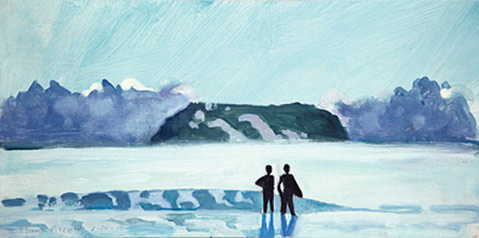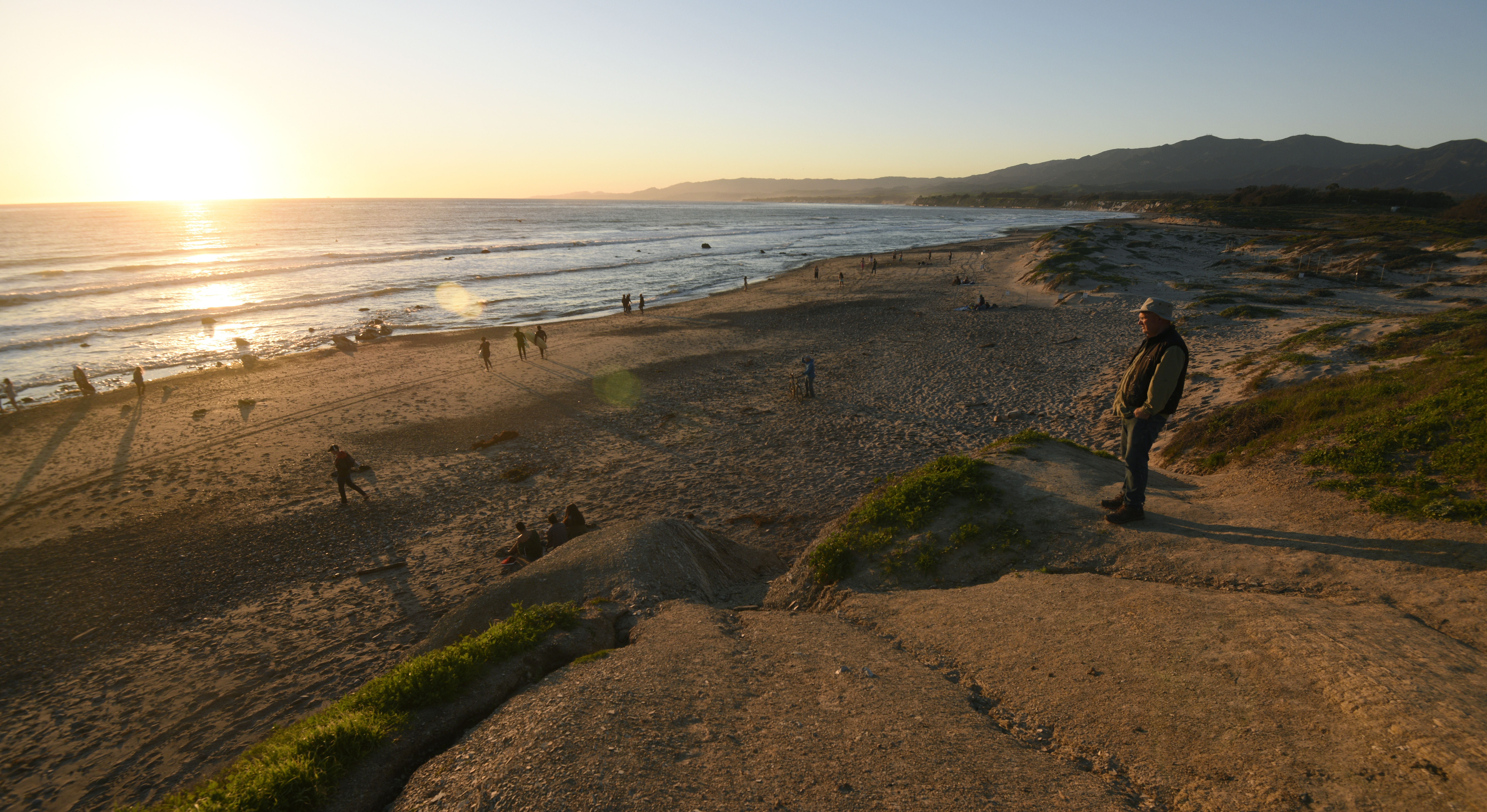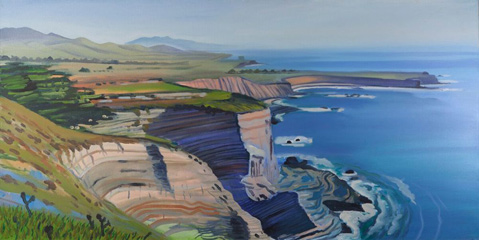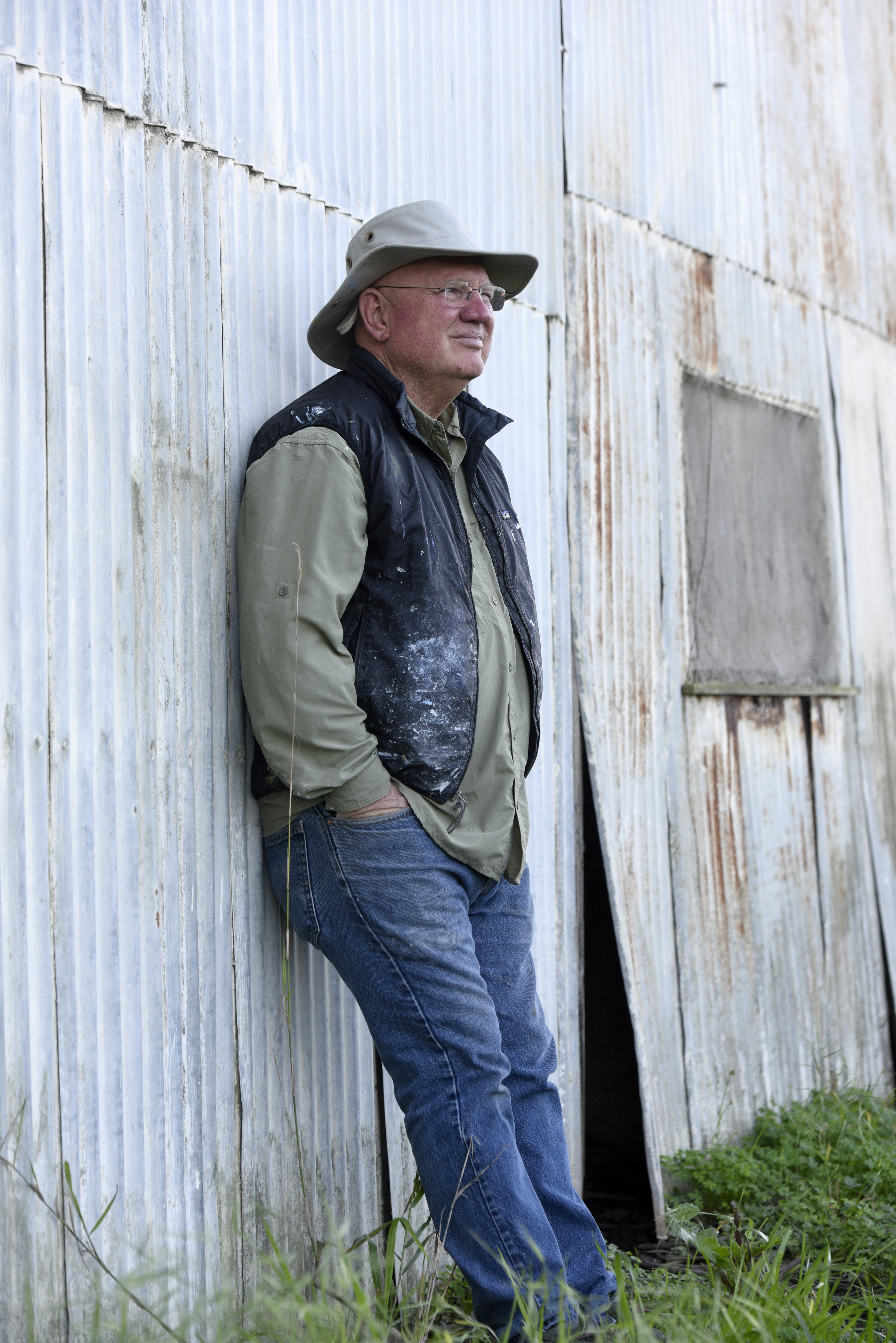“I always wanted to be regional, but I didn’t want to be provincial,” says Hank Pitcher. “I’m interested in the highest level of painting.”
There’s never been someone more relevant, poignant, and representative of modern Santa Barbara than Hank Pitcher. The 67-year-old landscape painter is renowned not only for five decades of artistic expression but also as an inspiring UCSB professor, a subtly effective environmentalist, and a legendary athlete. His life and career are a love letter to our uniquely beautiful stretch of coastline, particularly the landscape near Coal Oil Point, where he’s worked in a studio for more than 40 years just steps from his childhood home.
“I know it intimately through surfing and painting here over half a century,” he says of the entire Santa Barbara coastline. “I think that knowing or having an idea about a place is important to making an authentic statement about it. A lot of Santa Barbara has grown around me.”
Pitcher is mostly known for his colorful landscapes, although figurative works — including his emblematic paintings of surfboards — loom large in his oeuvre, as well. His style is neither realistic nor abstract, but it shows a deep duality that is as paradoxical as the man himself.
“There are two Hanks,” explains Frank Goss, who started showing Pitcher’s works at Sullivan Goss, An American Gallery on May 3, 2000. “There’s the football player who is expected to kick the ball. Then there’s the lyrical painter of landscapes.”
Pitcher’s new exhibit at Sullivan Goss, which opened March 2 and runs until April 30, is called Look Out. It’s a pertinent title, for that’s exactly what he’s been doing his entire life. “I like the multiple meanings,” explains Pitcher, enjoying that the phrase can be construed as a warning as well as an action and place. “Artists either look outward or inward. I usually look out,” he says. “My studio is a kind of lookout for surf, weather, things to paint. I have been fortunate to spend most of my life with a good view of the sea. Much of my work is about looking out to sea.” Such searching imbues Pitcher’s rich knowledge of our land and culture into his work.
I was originally going to interview Hank for The Santa Barbara Questionnaire I do each week for independent.com. But our 45-minute appointment turned into a three-hour chat, so we scheduled even more meetings to discuss art, cinema, the ocean, education, and Santa Barbara. Each time, I found him utterly fascinating and complex, gentle and soulful, always observing and contemplating. He seems to long for connection but also needs privacy to create.
And he’s unrelenting about the point of his work. “I am interested in how to get past the superficial, the tourist painting, the hackneyed,” he says. “That is one of the issues when painting beautiful places: In much of the art world, it is believed that paintings must be disturbing to be considered serious art.”
FIRST ENCOUNTER
It’s an early October afternoon when I first meet Hank at his studio, and his remarkable down-to-earth quality is immediately apparent. His walls are covered with landscapes that reflect his distinctive style, but I don’t recognize Santa Barbara in any them.
That’s because they are all from Scotland, where Pitcher recently traveled to paint the Royal & Ancient Golf Club of St. Andrews on commission for a collector. Though he also did another commission in England on the trip, Pitcher normally doesn’t take such jobs unless he can create a whole body of work around it.
“For a month in the summer, I painted the long light and the North Sea,” he said of Scotland, where he spent six weeks followed by two weeks in England. “I spent a lot of time speaking to caddies. It was sort of like Coal Oil Point. It had the same natural seepage.”

When I recognize one Scottish beach scene from the movie Chariots of Fire, he quickly acknowledges our common passion, admitting, “One of the biggest influences to my paintings has been film.” As a young man, he loved 1960s French films and Juliet of the Spirits by Federico Fellini, who helped him understand both the color green and composition. “My ambition with my paintings is for them to be like your favorite scene in a movie that you freeze,” said Pitcher, who believes his paintings translate well into black-and-white. “It should make you feel that you can walk into it.” And when he’s not listening to Miles Davis while he paints, he’ll often opt for film composer Nino Rota.
Traveling to paint, though, is not in his usual repertoire. His Scottish summer, in fact, was the longest period he’d ever spent painting outside of the country, but it served to reconnect him with his Santa Barbara microcosm.
“I work 200 yards from where I grew up,” said Pitcher, who was born in Pasadena on July 20, 1949, but moved to Isla Vista when he was 2 years old. “I learned to surf on the beach where my studio is.” His father, a carpenter named Henry, was hired as a foreman on UCSB’s first permanent building, so the family moved to a turquoise house on Abrego Road. Only about 100 families lived in Isla Vista then, and Hank was part of the first graduating class at Isla Vista Elementary School.
There was nothing but fields between his home and Highway 101, which had traffic lights all the way through Ventura then. “It was rural most of the way,” he recalled of family trips to Pasadena. “Farmland and cattle grazing, and then the thick yellow air of the L.A. basin. Sometimes the smog was so thick it was difficult to see across the street, and it hurt to breath.”
His dad told him the region would one day be filled with homes and businesses. “It didn’t seem possible,” said Pitcher. “That experience, as a young boy, contributes to my wanting to paint the places I love, the way I see them, as a way to preserve the way they are.”
In grade school, he was intrigued with how paintings could convey narratives and started buying reproductions of famous pieces. The first was “The Light of the World” by William Holman Hunt, which shows Jesus knocking on a door. “I was fascinated by the mystery,” he said.
But athletics pulled him with equal strength. “I became obsessive about football,” said Pitcher, who played at San Marcos High School on the first team to beat the mighty Santa Barbara Dons. Fistfights ensued. “I was really nuts as a football player,” said Pitcher, who played both offense and defense and would lose control during games, including the time he threw an opposing team’s star quarterback at the coach. “All of La Playa Stadium went quiet,” recalled Pitcher, who stood glaring at the coach, not realizing what he’d done. “Then half the stadium stood up and booed me, and then the other half stood up and cheered.” They won the game and went undefeated for the season. The other player went on to play wide receiver at Stanford.
Toward the end of our first meeting, Hank walks me to a spot on Coal Oil Point, where a full moon lingers on the horizon. He snaps a photo of me standing there and then whispers, almost as if he is thinking out loud, “I like stories. I like the mythology of the area.”

SECOND ENCOUNTER
Our next meeting is on a December morning at 7 a.m., when he shows me some of his surfboard paintings, including “The Mindbender and the Dovecote.” Set along the Gaviota Coast, it’s a portrait of an asymmetrical board shaped by Wayne Rich. When I look up close, I notice the whole painting is bizarre — the board floats out of the ground like the huge monolith in 2001: A Space Odyssey or Easter Island’s mo‘ais, and the background seems painted from differing perspectives.
“The key to a good realistic painting is that it has to be completely abstract,” says Pitcher. “I’m constantly making things bigger or smaller in order to tell my story.” The effect is visceral. In this case, it’s also a form of portraiture. “You know a lot about the person by looking at their surfboard,” he explains.
Frank Goss told me that Pitcher’s fans also refer to the surfboard pieces as portraits, including many New York–based investors and brokers who shop through the Sullivan Goss catalog to find the latest Hank Pitcher. “They’d love the strength in his paintings,” said Goss. “For them it’s a trophy. They’re really about power, uncompromising power.”
Then Hank brings out “Wayne Rich Nightmare,” another Wayne Rich surfboard portrait. Its darkness is menacing and dangerous. Noticing my reaction, he comments, “I like the whole range of ways people respond to my work. I like it when my paintings appear effortless and are accessible. As long as they enjoy some aspect of the work, I’m satisfied. The greatest films appeal to everyone.”
After high school, various colleges tried to lure Pitcher the athlete away from Santa Barbara, but he decided to stay. He’d seen a lecture by the iconoclastic architect/inventor/author Buckminster Fuller and decided to lead an intellectual life. In 1967, UCSB began its College of Creative Studies as “a graduate school for undergraduates,” and Pitcher was accepted into the literature program. But he wanted to paint. “One of the difficulties was that there weren’t people who could teach me what I wanted to learn,” he explained. “In the 1970s, there was an idea that painting was dead. Instead, conceptual art was encouraged.”
Nonetheless, the college’s small seminars put Pitcher in touch with such luminaries as painter Paul Wonner, choreographer Jacques d’Amboise, art critic Harold Rosenberg, scholar Hugh Kenner, and writer Marvin Mudrick. Upon graduation in 1971, some of Pitcher’s paintings were gaining acclaim, so he was asked to stay and teach, making him one of the youngest professors in the entire UC system.
“It turned into the best personal graduate program I could imagine,” said Pitcher, who used the college’s generous budget to invite such artists as John McCracken, Charles Garabedian, Jane Freilicher, and Alfred Leslie. “The students and I got to know firsthand what was happening everywhere in the art world,” he explained. “I picked them up from the airport, had meals with them, attended lectures, sat in on classes and critiques, went to the parties. They often visited my studio, and I was often invited to visit theirs in L.A. or New York. I had no other obligations at the time, and my only other interest was surfing.”
In 1971, hearing from a friend that there was great surf in New York, Pitcher drove across country with surfboards in tow and long blonde hair blowing in the wind. His friend’s parents rented a house on Georgica Beach in East Hampton, about a block from Grey Gardens. There, he met Paul Georges, a painter known for large-scale figurative allegories and self-portraits who’d been a student of Fernand Léger in Paris. Georges became Pitcher’s mentor and introduced him to artists such as Willem de Kooning, among others. For about a decade, Pitcher would summer in the Hamptons to hang out with that crowd.
One day in 1978, Pitcher was back in Santa Barbara and painting a couple posing on the corner of Sola and Anacapa streets when he met New Yorker Susan McKaba. It was his last day to work on the painting, which had taken a very long time, and he spotted her out of the corner of his eye. “I was struck, but she disappeared,” he recalls. Then she suddenly reappeared right in front of him, asking, “Are you Hank Pitcher?”
McKaba had attended a lecture of his but was leaving the next day for a new job in New York City. Smitten, Pitcher sold a catamaran and moved to New York to convince her to marry him. That year would prove to be the longest he ever lived away from Santa Barbara, but she did come back with him. They wed in 1985.
As Hank tells me this story, I notice a large garden painting from his recent English excursion that’s one of the most romantic I’ve seen yet, complete with a swing off to the left that says, “Will you marry me?” I can’t help but think of Susan and Hank’s courtship as I admire the painting’s simple and complex narrative. Everywhere in this garden there’s a story to be told. “I want my paintings to have that,” Pitcher explained. “Like a Fellini movie, you can get lost watching something happening in the background.”
He’s intently focused on conveying atmosphere, whether it’s of a lone person walking on the beach or a blue belly lizard about to get eaten by a white egret, and remains a student of sequential space, incorporating formal elements in three visual planes to create both depth and narrative.
“There are lots of points of entry in his landscapes,” explained Goss. “They are invitations to mystery and spirituality. He’s looking at the eternity of being. The intricate landscapes of his seem to go on and on.”

But Pitcher also struck creative gold in much simpler ways, too, like by designing the Mr. Zog’s Sex Wax logo (pictured) that hangs from a bulletin board in his studio. That happened in 1974, when Rick Herzog asked him to come up with both the logo and name for the now famous surfing wax. The brand was controversial but stuck, and Pitcher still gets “voluntary royalties” from Herzog.
Pitcher also created the first logo for Kinko’s. “This guy peeks in the door,” remembered Pitcher. “He was stuttering a lot, and he told me he had an idea for a mural in front of his store. It turns out it was Paul Orfalea. I hardly charged him, for I felt sorry for him.” Today, Pitcher’s studio is not far from the Orfalea Family Children’s Center on UCSB’s West Campus, paid for largely with Kinko’s money.
Pitcher still teaches every quarter at UCSB, mainly to serve as a mentor to young artists like so many did for him. He co-teaches a popular class with plant paleobiologist Bruce Tiffney called Field Painting with an Artist and a Botanist on the UC Reserves. Students are shown how to examine the entire natural landscape with eye and brush, focusing on the biological, geological, and artistic aspects of Coal Oil Point, Sedgwick Reserve, and other places in the university’s Natural Reserve System.

“They teach you to see what’s truly there,” explains artist Robin Gowen, who is Tiffney’s wife. “You put someone out in the field, and there are no boundaries. To break through is the real value of being plein air.” Of Pitcher the professor, she says, “He never tells a student how to paint. He tells them to go out and paint. If they hit an issue, then he encourages them to steal solutions from other painters. He plunges students without protection.”
Tiffney believes Pitcher’s paintings reflect nature better than any other medium. “You would think photographs can give you all the information, but photographs lie,” he said. “Hank heightens certain aspects that allow us to see more detail. Painting conveys more vegetation [than] the camera can.”
As such, Pitcher’s work actually preserves the landscape. “He profoundly understands that, when he paints, some things are going to change,” said Tiffney, who believes the visual record is of “extreme value” to the community and that it’s Pitcher’s way of being a subversive activist. “He feels at risk with the land at risk. He’s willing to be swallowed.”
“The landscape has a soul,” said Gowen, “and Hank captures the spirit of Southern California.”
THIRD ENCOUNTER
Later that month, on December 22, we’re in the studio again, observing the painting he worked on the day before. Every year, he paints the winter solstice, often at Point Conception. As I get lost in the still-damp work, he quietly starts telling me about the rhythms of the landscape. “The clouds are affected by the land and the mass beneath them,” he says. “Notice the way the wind is affecting the mountains. The ocean is a reflection of what is happening beneath. Everything is about everything else, the sounds of the landscape.”

This Hank is more meditative than before. “I’m interested in the idea of cosmological principles that you can finally notice by studying your own landscape,” he says as we sit at a table across from each other. “My paintings are all about living things. It’s important to sort things out.”
Though trying not to sound egotistical, he worries that the steady rise of landscape painters in Santa Barbara may miss the point. “No colors in landscape paintings of Santa Barbara had the colors I use until I started painting,” explained Pitcher, who believes many artists copy his scenes while using the palette he developed 40 years ago. “It makes a cliché out of something very meaningful to me,” he said, singling out Ray Strong as the region’s other influential landscape artist. “It is important for artists to have their own vision. I believe that is the job.”
For Pitcher, that vision centers on having an intimate relationship with his surroundings, which have changed much over his lifetime. “When I grew up here, there was nothing,” he recalled of a childhood spent playing in empty eucalyptus groves. “Slowly I started to see the destruction of the landscape. … I understood that painting was a way to make people aware.”
And it’s also an inspiration for people to get outside themselves, ever critical in today’s digital desk world. “If you take somebody to the beach and introduce them to the outdoors, there’s a great spirituality about that experience,” he explained. “Genetically, we’ve evolved in order to stand up and scan the horizon, to look out for protection and for food. When we stare at a computer at work, or sit at a desk answering calls, you start internalizing things. Your body closes in. Being in the landscape is essential to our mental and physical health. This was intuitive to me at an early age.”
Over the years, the endless development push has made him depressed at times, like when Camino Real Marketplace replaced the grasslands at Storke and Hollister. But he’s also seen victories, including UCSB’s long-ago purchase and recent expansion of the Coal Oil Point Reserve. “It’s been a roller coaster ride seeing it all being destroyed and then having it brought back,” said Pitcher. “Santa Barbara is such a model for conservation and art.”
Before I leave, I ask him one last question about how he got his name, which came from his dad. “I wanted to be called Hank because I didn’t like to be called ‘Little Henry,’” says Pitcher with a smile. As I say good-bye, I smile, too, realizing that the nickname would have never stuck for this giant steward of the Santa Barbara coast.
4·1·1 Hank Pitcher’s Look Out hangs at Sullivan Goss, An American Gallery (11 E. Anapamu St.) until April 30. See hankpitcher.com and sullivangoss.com.

